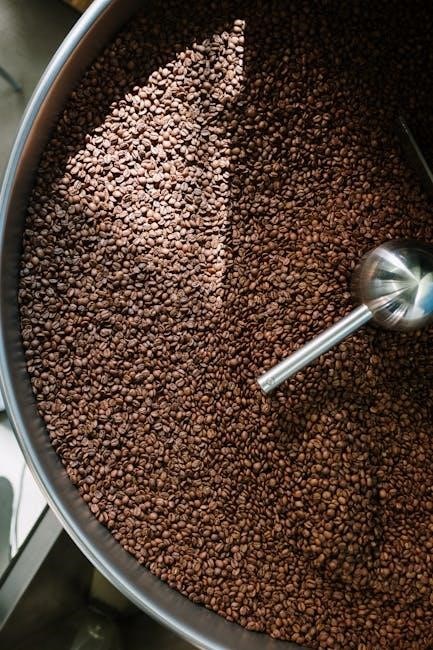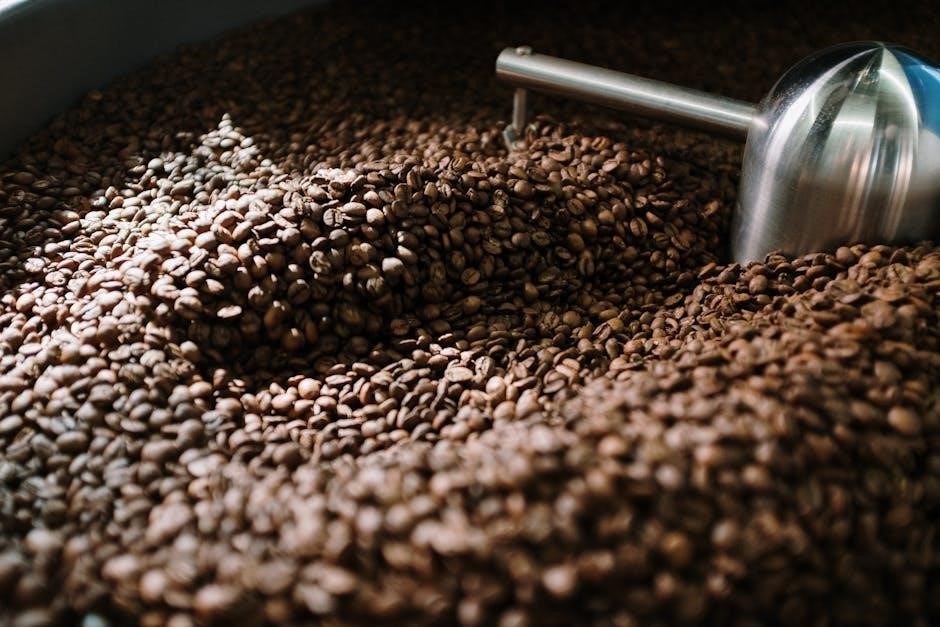Welcome! This guide provides comprehensive instructions for using your Aroma Turkey Roaster. From initial setup to safety‚ we’ll cover every step. Enjoy easy meal preparation with this versatile appliance‚ perfect for roasting a 24-pound turkey!


Initial Setup and Preparation
Before you begin using your Aroma Turkey Roaster‚ it’s essential to complete a few initial setup steps to ensure optimal performance and safety. First‚ carefully unpack the roaster oven and all its components‚ including the roasting pan‚ lid‚ and any included racks. Refer to the parts identification section of your Aroma Roaster Oven instruction manual to verify that you have all the necessary pieces. Remove all packaging materials‚ such as cardboard inserts‚ plastic wraps‚ and foam padding‚ from both the exterior and interior of the roaster oven. Be sure to check inside the cooking pan and under the lid for any remaining packing materials. Next‚ thoroughly inspect the roaster oven and its components for any signs of damage that may have occurred during shipping or handling. Check for dents‚ cracks‚ loose parts‚ or any other visible defects. If you notice any damage‚ do not use the roaster oven and contact Aroma Housewares customer support for assistance. Before plugging in the roaster oven for the first time‚ ensure that the power cord is in good condition and that the electrical outlet you plan to use is compatible with the roaster oven’s voltage requirements. Do not use an extension cord unless absolutely necessary‚ and if you do‚ make sure it is a heavy-duty extension cord rated for the roaster oven’s wattage. Place the roaster oven on a stable‚ level surface away from flammable materials and heat sources. Ensure that there is adequate ventilation around the roaster oven to prevent overheating. Read the Aroma Roaster Oven instruction manual carefully before proceeding to the next step. Familiarize yourself with all the safety precautions‚ operating instructions‚ and cooking tips provided in the manual. Keep the manual in a safe place for future reference. By following these initial setup and preparation steps‚ you can ensure that your Aroma Turkey Roaster is ready for safe and efficient operation‚ allowing you to enjoy delicious roasted meals for years to come. Remember‚ safety is paramount‚ so always prioritize following the manufacturer’s instructions and taking necessary precautions when using any electrical appliance. Once you’ve completed these steps‚ you’re ready to move on to cleaning the roaster oven before its first use.
Cleaning Before First Use
Before using your Aroma Turkey Roaster for the very first time‚ it is extremely important to thoroughly clean all of its components. This initial cleaning process ensures that any manufacturing residues‚ dust‚ or other potential contaminants are removed‚ guaranteeing a safe and sanitary cooking environment for your food. Start by disconnecting the roaster oven from the power outlet. Never attempt to clean the appliance while it is plugged in‚ as this poses a serious risk of electric shock. Once the roaster oven is unplugged‚ allow it to cool down completely before proceeding with the cleaning process. This will prevent burns and ensure your safety. Carefully remove the roasting pan‚ lid‚ and any included racks from the roaster oven body. These components are typically dishwasher-safe‚ but it is always recommended to check the Aroma Roaster Oven instruction manual for specific cleaning instructions. If you prefer to wash the components by hand‚ use warm‚ soapy water and a non-abrasive sponge or dishcloth. Avoid using abrasive cleaners‚ scouring pads‚ or steel wool‚ as these can scratch or damage the surfaces of the roasting pan‚ lid‚ and racks. Thoroughly wash each component‚ paying close attention to any areas that may have come into contact with packaging materials. Rinse each component thoroughly with clean‚ warm water to remove all traces of soap residue. Soap residue can impart an unpleasant taste to your food‚ so it is important to ensure that all soap is completely removed. After rinsing‚ dry each component thoroughly with a clean‚ dry towel. Avoid air-drying the components‚ as this can leave water spots or mineral deposits on the surfaces. Once the roasting pan‚ lid‚ and racks are clean and dry‚ wipe down the interior and exterior of the roaster oven body with a damp cloth. Do not immerse the roaster oven body in water or any other liquid‚ as this can damage the electrical components and pose a risk of electric shock. If there are any stubborn stains or food residues on the roaster oven body‚ you can use a mild cleaning solution or a paste made from baking soda and water to gently scrub the affected areas. After cleaning‚ wipe the roaster oven body with a clean‚ damp cloth to remove any remaining cleaning solution. Finally‚ dry the roaster oven body thoroughly with a clean‚ dry towel. Once all components are clean and dry‚ reassemble the roaster oven. Place the roasting pan back into the roaster oven body‚ and position the racks as desired. Ensure that the lid fits securely on top of the roaster oven body. Your Aroma Turkey Roaster is now clean and ready for its first use. Remember to consult the Aroma Roaster Oven instruction manual for specific cleaning instructions and safety precautions.
How to Use the Racks
The Aroma Turkey Roaster typically comes equipped with one or two racks‚ designed to enhance your roasting and cooking experience. Understanding how to properly utilize these racks is crucial for achieving optimal results and maximizing the versatility of your appliance. The most common type of rack is the roasting rack‚ often featuring handles for easy lifting and removal of your food. This rack serves multiple purposes‚ primarily elevating the food above the bottom of the roasting pan. This elevation allows for better air circulation around the food‚ promoting even cooking and browning. It also prevents the food from sitting directly in the drippings‚ which can lead to soggy or unevenly cooked results. The roasting rack can also be used for fat-free roasting. By elevating the food‚ excess fat and grease can drip away from the food and into the bottom of the pan‚ resulting in a healthier meal. Some Aroma Turkey Roasters also include a flat rack‚ which can be used in conjunction with the roasting rack for two-level cooking. This allows you to cook multiple dishes simultaneously‚ saving time and energy. For example‚ you could roast a turkey on the roasting rack while steaming vegetables on the flat rack. To use the racks effectively‚ first ensure that the roasting pan is clean and dry. Place the roasting rack inside the roasting pan‚ making sure it sits securely on the bottom. If you are using the flat rack for two-level cooking‚ position it above the roasting rack‚ ensuring there is enough space between the two racks to allow for adequate air circulation. When placing food on the racks‚ avoid overcrowding. Overcrowding can restrict air circulation and lead to uneven cooking. Make sure there is enough space between the food items to allow for even heat distribution. If you are roasting a large turkey‚ ensure that it is centered on the roasting rack to prevent it from tipping over. Use the handles on the roasting rack to carefully lift and remove the food from the roaster oven when it is done cooking. Be sure to use oven mitts or pot holders to protect your hands from the heat. When using the racks for steaming‚ add water to the bottom of the roasting pan‚ making sure the water level does not reach the bottom of the racks. This will allow the steam to circulate around the food without it sitting in the water. Refer to the Aroma Roaster Oven instruction manual for specific instructions on how to use the racks for different cooking methods and recipes. The manual may also provide additional tips and tricks for maximizing the performance of your racks. Always follow the safety precautions outlined in the manual when using the racks‚ and never exceed the maximum weight capacity of the racks. By understanding how to properly use the racks in your Aroma Turkey Roaster‚ you can unlock its full potential and enjoy delicious‚ evenly cooked meals every time.

Roasting Guide Chart: Time and Temperature
Achieving a perfectly roasted turkey in your Aroma Roaster Oven relies heavily on adhering to the correct time and temperature guidelines. The following roasting guide chart provides estimated cooking times and temperatures for various sizes of whole turkeys. Please note that these are approximate values and may need to be adjusted based on factors such as the specific model of your roaster oven‚ the starting temperature of the turkey‚ and personal preferences for doneness. Always use a meat thermometer to ensure that the turkey reaches a safe internal temperature before serving. For a whole turkey weighing 10-17 pounds‚ the recommended oven temperature is between 350-400°F (175-200°C). The approximate roasting time is typically 2 to 3 hours‚ or 13 to 18 minutes per pound. For a larger whole turkey weighing 18-20 pounds‚ maintain the oven temperature between 350-400°F (175-200°C). The approximate roasting time will be longer‚ ranging from 3 to 4 hours‚ or 12 to 16 minutes per pound. It’s crucial to monitor the internal temperature of the turkey throughout the roasting process. Insert a meat thermometer into the thickest part of the thigh‚ avoiding the bone. The turkey is considered done when the thermometer registers 165°F (74°C). To ensure even cooking‚ it’s recommended to rotate the turkey halfway through the roasting time. This will help to prevent one side from browning more quickly than the other. If the turkey starts to brown too much before it reaches the desired internal temperature‚ you can loosely tent it with aluminum foil. This will help to slow down the browning process and prevent the skin from burning. Remember to remove the foil during the last 30 minutes of cooking to allow the skin to crisp up. Always allow the turkey to rest for at least 10-15 minutes after removing it from the roaster oven. This allows the juices to redistribute throughout the meat‚ resulting in a more moist and flavorful turkey. The roasting guide chart is a helpful tool‚ but it’s important to use your own judgment and experience to determine the optimal cooking time and temperature for your turkey. Factors such as the age and breed of the turkey can also affect the cooking time. Regularly check the internal temperature of the turkey and adjust the cooking time as needed. By following these guidelines and using a meat thermometer‚ you can ensure that your Aroma Roaster Oven produces a perfectly roasted turkey every time. Enjoy your delicious and moist Thanksgiving feast!
Preparing the Turkey
Preparing your turkey properly is a crucial step in ensuring a delicious and safe roasting experience in your Aroma Roaster Oven. This process involves several key steps‚ starting with thawing the turkey completely. The thawing method significantly impacts the turkey’s texture and cooking time. The safest and most recommended method is thawing in the refrigerator. Allow approximately 24 hours of thawing time for every 5 pounds of turkey weight. Ensure the turkey is placed on a tray or in a container to catch any drips and prevent cross-contamination in your refrigerator. Alternatively‚ you can thaw the turkey in cold water. Submerge the turkey completely in a large container filled with cold water‚ changing the water every 30 minutes to maintain a safe temperature. This method requires approximately 30 minutes of thawing time per pound of turkey. Avoid thawing the turkey at room temperature‚ as this can promote bacterial growth and increase the risk of foodborne illness. Once the turkey is fully thawed‚ remove it from its packaging and rinse it thoroughly under cold running water. Pat the turkey dry inside and out with paper towels. This step helps to remove any lingering ice crystals or moisture and allows for better browning of the skin during roasting. Next‚ remove the neck and giblets from the turkey’s body cavity. These can be used to make gravy or stock‚ or they can be discarded. Check both the main cavity and the neck cavity for any remaining parts. Now‚ it’s time to season the turkey. You can use a variety of herbs‚ spices‚ and seasonings to enhance the flavor of the turkey. Popular options include salt‚ pepper‚ garlic powder‚ onion powder‚ paprika‚ thyme‚ rosemary‚ and sage. You can season the turkey both inside and out. For the interior‚ consider adding aromatic vegetables such as onions‚ celery‚ and carrots‚ along with fresh herbs like thyme and rosemary. These will infuse the turkey with flavor from the inside out. For the exterior‚ you can rub the turkey with melted butter or oil to promote browning and crisping of the skin. Season generously with your chosen herbs and spices. Some people prefer to brine their turkey before roasting. Brining involves soaking the turkey in a saltwater solution for several hours‚ which helps to retain moisture and results in a more tender and flavorful bird. If you choose to brine your turkey‚ be sure to adjust the seasoning accordingly‚ as the brining solution will already add salt to the meat. Finally‚ place the prepared turkey on the roasting rack that comes with your Aroma Roaster Oven. Ensure the turkey is positioned breast-side up for even cooking. Your turkey is now ready to be roasted to perfection in your Aroma Roaster Oven. Remember to consult the Roasting Guide Chart for recommended cooking times and temperatures based on the size of your turkey.
Cooking Process
The cooking process is where your prepared turkey transforms into a golden-brown‚ succulent centerpiece‚ all thanks to your Aroma Roaster Oven. Before you even think about placing the turkey inside‚ preheating the roaster oven is a must. Preheat it to the temperature specified in the Roasting Guide Chart‚ usually around 350°F (175°C)‚ for at least 20 minutes. This ensures consistent heat distribution from the start‚ promoting even cooking. Carefully place the turkey‚ already positioned on the roasting rack‚ into the preheated roaster oven. Make sure the rack is properly seated in the cooking pan to prevent any wobbling or uneven cooking. Cover the roaster oven with its lid. This is crucial for trapping heat and moisture‚ which helps the turkey cook evenly and prevents it from drying out. Now comes the waiting game. Roasting time depends heavily on the turkey’s weight. Consult the Roasting Guide Chart for the recommended cooking time per pound. As a general guideline‚ allow approximately 13-18 minutes per pound for a turkey weighing between 10-17 pounds‚ and 12-16 minutes per pound for a turkey weighing between 18-20 pounds. However‚ relying solely on time is not enough. The most accurate way to determine if the turkey is done is by using a meat thermometer. Insert the thermometer into the thickest part of the thigh‚ being careful not to touch the bone. The turkey is done when the internal temperature reaches 165°F (74°C). For optimal results‚ check the temperature in multiple locations‚ including the breast and other parts of the thigh‚ to ensure the entire turkey is cooked through. Basting is a technique that involves spooning pan juices over the turkey during roasting to keep it moist and enhance its flavor. While not strictly necessary with a roaster oven‚ basting can contribute to a richer‚ more flavorful bird. If you choose to baste‚ do so every 30-45 minutes. Open the lid quickly to minimize heat loss‚ and use a bulb baster or large spoon to collect the juices from the bottom of the pan and drizzle them over the turkey. Be mindful not to over-baste‚ as excessive moisture can hinder browning. If you notice the turkey skin is browning too quickly‚ you can tent it with aluminum foil. Simply loosely cover the breast with foil to shield it from direct heat. Remove the foil during the last 30-45 minutes of cooking to allow the skin to crisp up. Once the turkey reaches the correct internal temperature‚ carefully remove it from the roaster oven. Use oven mitts or pot holders to protect your hands from the heat. Transfer the turkey to a cutting board and tent it loosely with aluminum foil. Let it rest for at least 20-30 minutes before carving. This allows the juices to redistribute throughout the meat‚ resulting in a more tender and flavorful turkey. While the turkey is resting‚ you can use the pan drippings to make gravy. Skim off any excess fat from the drippings‚ then whisk in flour or cornstarch to thicken. Add broth or water to reach your desired consistency‚ and season with salt‚ pepper‚ and any other herbs or spices you like. Carve the turkey and serve it with your favorite side dishes. Enjoy the fruits (or rather‚ the bird) of your labor! The Aroma Roaster Oven has once again delivered a perfectly cooked and delicious turkey.
Safety Precautions
Cleaning After Use

Cleaning your Aroma Turkey Roaster after use is crucial for maintaining its performance and longevity. A clean roaster not only ensures hygiene but also prevents buildup that can affect future cooking results. Begin the cleaning process by ensuring the roaster is completely cooled down. Never attempt to clean the roaster while it’s still hot‚ as this poses a burn risk and can damage the appliance. Once cooled‚ unplug the roaster from the electrical outlet. This is a fundamental safety precaution to prevent electrical shock during cleaning. Remove the cooking pan and roasting rack from the roaster oven. These are the components that come into direct contact with food and will require thorough cleaning. Carefully discard any leftover food scraps from the cooking pan and rack into the trash or compost. This prevents food from hardening and becoming difficult to remove later. Wash the cooking pan and roasting rack with warm‚ soapy water. Use a non-abrasive sponge or dishcloth to avoid scratching the surfaces. For stubborn‚ stuck-on food residue‚ you can soak the pan and rack in warm‚ soapy water for 15-30 minutes before washing. If soaking doesn’t completely remove the residue‚ try using a paste of baking soda and water. Apply the paste to the affected areas‚ let it sit for a few minutes‚ and then scrub gently. Rinse the cooking pan and roasting rack thoroughly with clean‚ warm water to remove all traces of soap. Soap residue can leave an unpleasant taste or odor and may affect future cooking results. Dry the cooking pan and roasting rack completely with a clean towel or allow them to air dry. Moisture can lead to rust or mildew growth‚ especially if the roaster is stored in a humid environment. Wipe down the interior and exterior of the roaster oven with a damp cloth. Again‚ avoid using abrasive cleaners or scouring pads‚ as these can damage the finish. For stubborn stains or spills on the exterior‚ you can use a mild all-purpose cleaner. Ensure the cleaner is safe for use on the roaster’s material (usually stainless steel or enamel). Never immerse the roaster oven body in water or any other liquid. The roaster oven contains electrical components that can be damaged by water‚ posing a safety hazard. If necessary‚ you can carefully wipe the inside of the roaster oven with a slightly damp cloth‚ being careful not to get any water on the heating element or electrical connections. Ensure the roaster is completely dry before storing it. Store the roaster oven in a cool‚ dry place. Avoid storing it in direct sunlight or near sources of heat‚ as this can damage the appliance. You can store the cooking pan and roasting rack inside the roaster oven for convenient storage. Refer to your Aroma Roaster Oven instruction manual for any specific cleaning instructions or recommendations. Following these cleaning steps will help you keep your Aroma Turkey Roaster in excellent condition‚ ensuring many years of reliable and delicious cooking.

Leave a Reply
You must be logged in to post a comment.